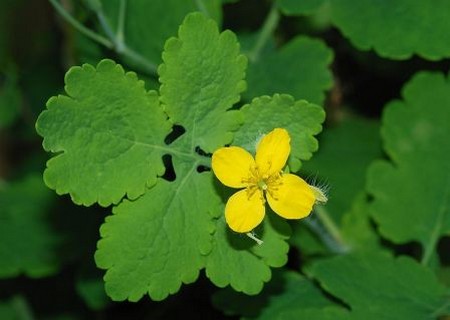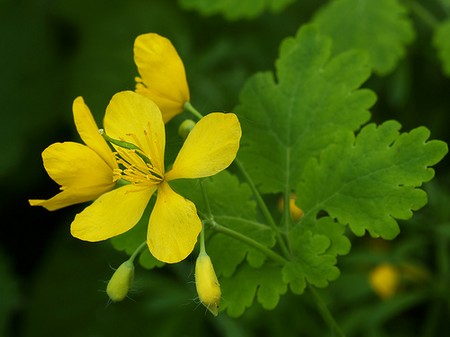Greater celandine is a member of the poppy family and shows many of the poppy’s actions in healing. It is indigenous to Europe and is remarkably resilient, flourishing where other plants would not survive. It can be found in waste places, growing against walls and fences, and in small cracks in walls and pavements. When cut or bruised it exudes a bright yellow-orange juice that tastes bitter and acrid, much like the juice of a poppy.
The name Chelidonium comes from the Greek word chelidon, meaning swallow, because of an old belief that the swallow carried the plant to its nest to open the eyes of its young. It is also thought that the name derives from the simple fact that greater celandine comes into flower when the swallows arrive and fades when they leave. To the alchemists greater celandine was very special and they used it in their search for the philosopher’s stone, calling it coelidonum, meaning gift of heaven.
Herbal remedy
Greater celandine has been used in healing since the days of the Ancient Greeks and Romans. As the story of the swallow indicates, the plant has a special affinity for the eve, and was given to remedy a whole range of eye problems that caused problems with vision. Francis Bacon said, ‘saladyne hath a yellow milk which hathe also much acrimonie for it cleanseth the eyse and is good for cataract’, while Gerard stated, ‘the juice of the herbs is good to sharpen the sight, for it cleanseth and consumcth away slimie things that cleave about the ball of the eye and hinder the sight’. It is still used by medical herbalists for infections and inflammation of the eye.
According to the doctrine of signatures, the bright orange-yellow juice indicated the plant’s use in liver and gall-bladder problems. It was recommended for obstructions of the liver and gall-bladder, jaundice, infections, gallstones, and pain in the liver area. The plant tastes very bitter and by stimulating the bitter receptors in the mouth, greater celandine stimulates the flow of digestive juices and bile.
Paracelsus was aware of the plant’s healing properties. He classified it as a ‘blood’ herb for circulatory problems and as a ‘yellow’ herb for liver ailments and jaundice. By cleansing the liver and stimulating the kidneys, greater celandine acts as an alterative, aiding the detoxifying action of the body. As a diuretic it aids elimination of toxins via the urine, and relieves fluid retention. It can be given for rheumatism and gout, as well as allergies and toxic conditions which give rise to skin problems.
Like the poppy, greater celandine has narcotic properties and is only ever used in small doses by qualified medical herbalists. As a sedative it aids sleep, reduces tension and anxiety and relieves pain. It has an antispasmodic effect particularly in the respiratory system.
Externally, the plant is perfectly safe for home use and makes a wonderfully effective remedy for warts and verrucae when the fresh juice is applied directly.
Homeopathic remedy: Chelidonium
Chelidonium reflects much of its action when used as a herb. It is predominantly a liver remedy, indicated by a continual bruised pain or ache under the right shoulder blade, with a variety of symptoms indicative of liver or gall-bladder problems.
Like the opium poppy, chelidonium is given for debility and drowsiness, which tends to occur after eating and on waking, and is given for paralysis. It also acts on the respiratory system and is indicated by dry, racking coughs which are worse at night, with little expectoration and no pain. Chelidonium is also given for rheumatism or arthritis, where oedema, heat, tenderness and stiffness are leading indications.
The flower essence
As the herb was used historically to sharpen the sight, the flower essence is recommended to sharpen the mind and enhance the giving and receiving of information. It is the remedy of communication, and has an affinity for the throat area, and the thyroid gland. It makes a good remedy for singers, teachers and lecturers as it helps articulation. It is useful for people who have difficulty taking in information, such as those who are stubborn and opinionated, or who do not listen, or who cannot concentrate for long. It is said to increase the possibility of telepathic communication, and enhance the understanding of information given in dreams. Thus it affects not only the sight and the mind, but also inner vision.

